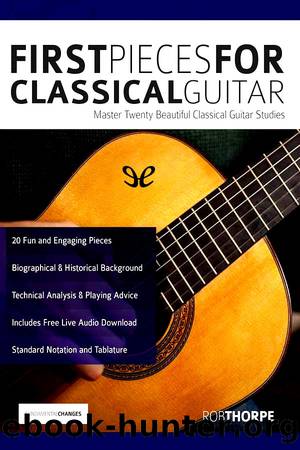First pieces for classical guitar by Rob Thorpe

Author:Rob Thorpe [Thorpe, Rob]
Language: eng
Format: epub
Tags: Novela, Otros
Publisher: ePubLibre
Published: 2018-04-23T00:00:00+00:00
Op. 1, Pt. 3, N1 - M. Giuliani
11. Op. 1, Pt. 3, No. 3 â M. Giuliani
The third piece from Giulianiâs Op. 1 set of studies has more of a bouncing feel than the previous selection. Giulianiâs own instructions state that the I and M fingers should pluck in a strictly alternating fashion to avoid fatigue developing in the right hand.
Carulli's Andantino (page 22) briefly uses this technique to play notes on a single string for short phrases, but here it is the subject of the whole study. Rest your thumb on the low E-string as an anchor point and play only the melody line until itâs relaxed and accurate.
The rhythmic notation shows that each pair of notes is composed of a dotted semiquaver followed by a demisemiquaver. This rhythm may look a bit unnerving, but on listening to the audio, you will hear that the second note is delayed a bit, so that it rushes into the next strong beat. To produce these two quick notes, it is especially important to follow the picking instructions above.
The stated tempo is allegro, indicating that it should be played quite fast. However, I've played it at a more sedate tempo which gives the melody a bit more space. The strict plucking technique should be adhered to, so that with practise you will be able to play it at a range of tempos, as well as developing the technique needed for other pieces of a similar style.
Compare the two pieces from Giulianiâs Op. 1 with the other classical period compositions and youâll notice that his phrases are much longer than most. While other pieces phrase in four-bar patterns, the melody in this piece doesnât really come to rest until the start of bar eight.
There are several pick-up beats in the tune, including the very first phrase. The eagle-eyed reader will spot that bar twelve is missing a quaver for the correct rhythmic value for a 2/4 bar. It was a convention of the period to repeat back to the start and include the pick-up bar again. On the repetition, however, the pick-up counts as part of the preceding bar. After the second repeat at bar twelve, bar thirteen also has a pick-up which completes the previous bar's rhythmic value.
Download
This site does not store any files on its server. We only index and link to content provided by other sites. Please contact the content providers to delete copyright contents if any and email us, we'll remove relevant links or contents immediately.
Kathy Andrews Collection by Kathy Andrews(10520)
The remains of the day by Kazuo Ishiguro(7551)
Spare by Prince Harry The Duke of Sussex(4198)
Paper Towns by Green John(4169)
The Body: A Guide for Occupants by Bill Bryson(3802)
Be in a Treehouse by Pete Nelson(3213)
Harry Potter and the Goblet Of Fire by J.K. Rowling(3046)
Goodbye Paradise(2964)
Never by Ken Follett(2881)
Into Thin Air by Jon Krakauer(2701)
The Remains of the Day by Kazuo Ishiguro(2619)
The Genius of Japanese Carpentry by Azby Brown(2609)
The Cellar by Natasha Preston(2595)
Drawing Shortcuts: Developing Quick Drawing Skills Using Today's Technology by Leggitt Jim(2532)
120 Days of Sodom by Marquis de Sade(2438)
Architecture 101 by Nicole Bridge(2350)
The Man Who Died Twice by Richard Osman(2300)
Machine Learning at Scale with H2O by Gregory Keys | David Whiting(2292)
Fairy Tale by Stephen King(2070)
